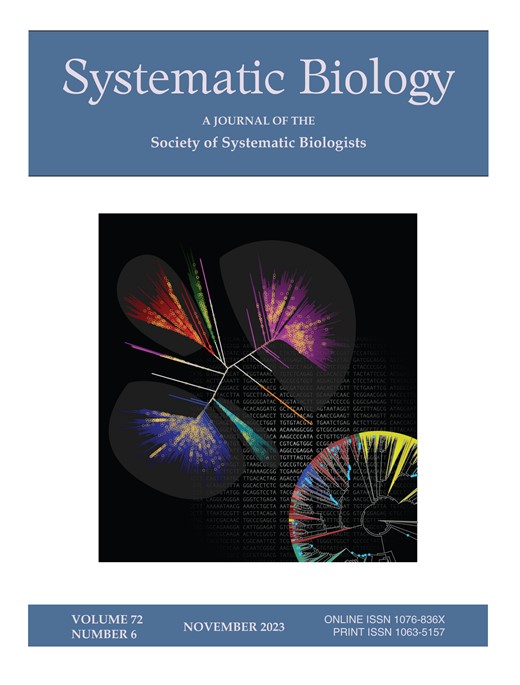The consequences of budding speciation on trees
IF 5.7
1区 生物学
Q1 EVOLUTIONARY BIOLOGY
引用次数: 0
Abstract
Paleobiologists have long sought to explain how alternative modes of speciation, including budding and bifurcating cladogenesis, shape patterns of evolution. Methods introduced over the past decade have paved the way for a renewed enthusiasm for exploring modes of speciation in the fossil record. However, the field does not yet have a strong intuition for how ancestor-descendant relationships, especially those that arise from budding speciation, might influence the shape of trees reconstructed for fossil or living clades. We developed a simulation approach based on classic paleobiological theory to ask what proportion of ancestral nodes in paleontological phylogenies are expected to correspond to sampled taxa under a range of preservational regimes. We compared our simulated results to empirical estimates of absolute fossil record completeness gathered from the literature and found that many fossilized clades of marine invertebrates are likely to display upwards of 80% sampled ancestors. Under a primarily budding model, phylogenies where 100% of the internal nodes correspond to named species are very possible for well-sampled clades at local and regional scales. We also leveraged our simulation approach to ask how budding might shape extant clades. We found that the ancestral signature of budding causes rampant hard polytomies (i.e., multifurcations), greatly impacting the shape of extant clades. Our results highlight how budding can yield dramatic and unrecognized effects on phylogenetic reconstruction of clades of both living and extinct organisms.树木的萌芽物种形成的后果
古生物学家长期以来一直试图解释物种形成的不同模式,包括萌芽和分叉枝发生,是如何塑造进化模式的。过去十年中引入的方法为探索化石记录中物种形成模式的新热情铺平了道路。然而,对于祖先-后代关系,特别是那些从萌芽的物种形成中产生的关系,如何影响为化石或活枝重建的树木的形状,这个领域还没有一个强烈的直觉。我们开发了一种基于经典古生物学理论的模拟方法,以询问在一系列保存制度下,古生物系统发育中祖先节点的比例预计与样本分类群相对应。我们将模拟结果与从文献中收集的绝对化石记录完整性的经验估计进行了比较,发现许多海洋无脊椎动物的化石分支可能显示了80%以上的样本祖先。在萌芽模式下,100%的内部节点对应于命名物种的系统发育在局部和区域尺度上是非常可能的。我们还利用我们的模拟方法来询问萌芽如何塑造现存的进化枝。我们发现,出芽的祖先特征导致了猖獗的硬多裂(即多功能),极大地影响了现存进化枝的形状。我们的研究结果强调了萌芽如何对现存和灭绝生物的进化枝的系统发育重建产生戏剧性的和未被认识到的影响。
本文章由计算机程序翻译,如有差异,请以英文原文为准。
求助全文
约1分钟内获得全文
求助全文
来源期刊

Systematic Biology
生物-进化生物学
CiteScore
13.00
自引率
7.70%
发文量
70
审稿时长
6-12 weeks
期刊介绍:
Systematic Biology is the bimonthly journal of the Society of Systematic Biologists. Papers for the journal are original contributions to the theory, principles, and methods of systematics as well as phylogeny, evolution, morphology, biogeography, paleontology, genetics, and the classification of all living things. A Points of View section offers a forum for discussion, while book reviews and announcements of general interest are also featured.
 求助内容:
求助内容: 应助结果提醒方式:
应助结果提醒方式:


